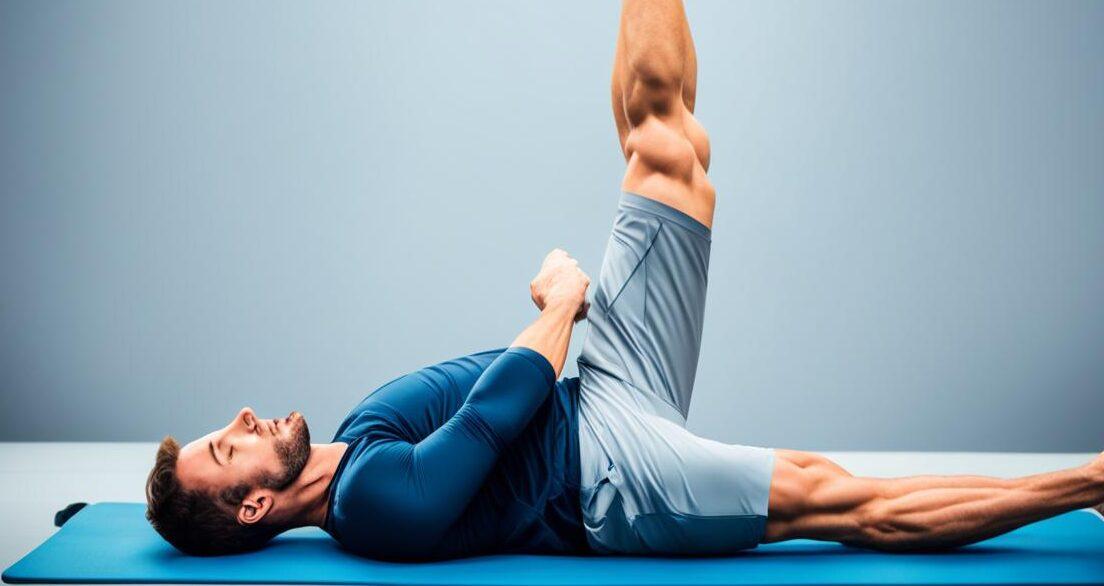Millions of Americans suffer from lower back pain, but did you know that strengthening your core can help alleviate discomfort and improve your overall quality of life? Whether you’re an athlete or lead a more sedentary lifestyle, focusing on your core muscles can provide relief and support for your lower back.
When it comes to Ab exercises for lower back pain , there are specific ones that target your abdominal muscles without straining your lower back. These exercises not only help tone your midsection but also alleviate pain and reduce the risk of injury. By incorporating these exercises into your routine, you can strengthen your core, reduce discomfort, and improve your spinal stability.
In this article, we will explore the importance of core strength for lower back pain, learn core exercises that can strengthen your muscles without straining your lower back, understand the role of mobility in reducing discomfort, and discover valuable tips for preventing lower back pain. We will also explore the benefits of core strength for older adults and discuss the link between core strength and spinal stability.
Key Takeaways:
- Strengthening your core can help alleviate lower back pain and improve your overall quality of life.
- Choose core exercises that target your abdominal muscles without straining your lower back.
- Address mobility issues through gentle stretching exercises.
- Engage your core during daily activities and maintain proper posture and lifting mechanics.
- Consult with a healthcare professional for personalized advice and guidance.
The Importance of Core Strength for Lower Back Pain
Core strength plays a vital role in supporting the lower back, improving posture, and maintaining balance. When the core muscles are weak, it can lead to increased stress on the spine, resulting in lower back pain and a higher risk of injury. Strengthening the core is essential for alleviating chronic low back pain and reducing dependence on passive structures like ligaments and bones.
A strong core provides the necessary support and stability for the lower back, reducing the strain on the surrounding muscles and tissues. It helps maintain proper alignment of the spine, preventing excessive curvature and promoting a more neutral posture. By improving posture, core strength contributes to better spinal alignment and decreases the likelihood of experiencing lower back pain.
In addition to supporting the lower back, a strong core also enhances overall balance. The core muscles work in harmony with the other muscles in the body to maintain stability during movements and activities. By strengthening the core, individuals can improve their balance, reducing the risk of falls and related injuries.
Whether you’re an athlete looking to enhance performance or someone experiencing chronic lower back pain, focusing on core strength is essential. By incorporating core-strengthening exercises into your routine, you can build a solid foundation of support, improve your posture, and enhance your overall balance.
“Strong core muscles provide the necessary support and stability for the lower back, reducing the strain on surrounding tissues and promoting a healthier spine.
Benefits of Core Strength for Lower Back Pain:
- Provides support for the lower back
- Improves posture and spinal alignment
- Enhances balance and stability
- Reduces the risk of injury
By strengthening your core, you can experience relief from lower back pain, improve your overall quality of life, and minimize the likelihood of future injuries.
| Exercise | Focus | Description |
|---|---|---|
| Pelvic Tilts | Core stability | Lie on your back with knees bent and feet flat. Gently tilt your pelvis upward, engaging your core muscles. Hold for a few seconds, then release. |
| Supine Marches with Pelvic Tilt | Core strength and stability | Lie on your back with knees bent and feet flat. Lift one foot off the ground, maintaining a pelvic tilt. Alternate legs in a marching motion. |
| Transversus Abdominis Contractions | Core activation | Lie on your back with knees bent and feet flat. Gently draw your belly button toward your spine, engaging your deep core muscles. Hold for a few seconds, then release. |
| Heel Slides with Transversus Abdominis Contraction | Core strength and stability | Lie on your back with knees bent and feet flat. Slowly slide one heel away from your body, engaging your core. Bring the heel back to the starting position and repeat with the other leg. |
| Dead Bugs | Core strength and stability | Lie on your back with your arms extended toward the ceiling and knees bent at a 90-degree angle. Simultaneously extend one leg and the opposite arm while keeping the core engaged. Return to the starting position and repeat with the other leg and arm. |
Core Exercises to Strengthen Without Straining the Lower Back
When it comes to strengthening your core to address lower back pain, it’s crucial to choose exercises that won’t strain your lower back. By avoiding twisting movements and focusing on stability exercises, you can effectively alleviate pain and prevent further discomfort. Incorporating the following core exercises into your routine can help you strengthen your core without exacerbating lower back strain:
- Pelvic tilts
- Supine marches with pelvic tilt
- Transversus abdominis contractions
- Heel slides with transversus abdominis contraction
- Dead bugs
- Modified dead bugs
- Bird dogs
- Planks
- Side planks
These exercises specifically target the core muscles without placing excessive strain on the lower back. They help improve stability, strengthen the muscles surrounding the spine, and alleviate discomfort. Remember to perform these exercises with proper form and start with modifications or variations that suit your fitness level.
Strengthening your core is essential for maintaining a healthy back and reducing lower back pain. These exercises can be performed at home or at the gym, making them accessible to individuals of all fitness levels. Consistency is key—incorporate these core exercises into your regular workout routine to experience the benefits and avoid exacerbating lower back pain.
The Role of Mobility in Lower Back Pain
Addressing mobility issues is crucial for reducing lower back pain. If certain movements like twisting or bending cause discomfort, there may be mobility issues that need to be addressed. Gentle stretching exercises, such as yoga poses, can help improve flexibility and reduce movement-related discomfort.
When it comes to lower back pain, mobility plays a significant role. Limited mobility can lead to muscle imbalances and increased stress on the spine, resulting in discomfort and pain. By improving your mobility, you can enhance your overall movement and decrease the risk of further aggravating your lower back.
Gentle stretching exercises are particularly beneficial for improving mobility and reducing lower back pain. Yoga poses, in particular, can promote flexibility, increase blood flow to the surrounding muscles, and provide relief from discomfort. Here are a few gentle stretches that can help:
- Child’s Pose: This pose stretches the muscles in your lower back, hips, and thighs. Start by kneeling on the floor, then lower your buttocks towards your heels as you reach your arms forward and place your forehead on the mat.
- Cat-Cow Pose: This pose helps to increase the flexibility and mobility of your spine. Begin on your hands and knees, and as you inhale, arch your back, lifting your chest towards the ceiling. As you exhale, round your spine and tuck your chin towards your chest.
- Supine Twist: Lie on your back with your knees bent. Gently drop your knees to one side while keeping your upper body flat on the ground. Hold the stretch for a few breaths, then switch to the other side.
Incorporating these gentle stretching exercises into your routine can improve your mobility, increase flexibility, and reduce movement-related discomfort. Remember to listen to your body and not push yourself too hard. Start with small movements and gradually increase the intensity and duration of your stretches as your flexibility improves.
Why Should You Focus on Mobility for Lower Back Pain?
Improving your mobility can alleviate lower back pain by reducing muscle imbalances and increasing the range of motion in your spine.
When you have limited mobility in your lower back, the surrounding muscles may compensate by working harder, leading to imbalances and discomfort. By incorporating gentle stretching exercises into your routine, you can address these imbalances, improve your flexibility, and promote optimal movement patterns.
Moreover, increased mobility can enhance your overall quality of life. It allows you to perform daily activities with ease, participate in physical activities without hesitation, and maintain an active lifestyle. By prioritizing mobility, you can regain control over your body and reduce the impact of lower back pain on your daily life.

| Exercise | Description | Benefit |
|---|---|---|
| Child’s Pose | Kneeling on the floor, lower your buttocks towards your heels as you reach your arms forward and place your forehead on the mat. | Stretches lower back, hips, and thighs |
| Cat-Cow Pose | On your hands and knees, inhale as you arch your back, lifting your chest towards the ceiling. Exhale as you round your spine and tuck your chin towards your chest. | Increases flexibility and mobility of the spine |
| Supine Twist | Lie on your back with knees bent. Gently drop your knees to one side while keeping your upper body flat on the ground. | Stretches the lower back and promotes spinal mobility |
By incorporating these gentle stretching exercises into your routine, you can improve your mobility, reduce lower back pain, and enhance your overall well-being. Remember to consult with a healthcare professional if you have any underlying medical conditions or concerns before starting a new exercise regimen.
Tips for Ab Exercises for Lower Back Pain
When it comes to strengthening the core and preventing lower back pain, it’s important to go beyond just exercise. Incorporating core engagement into your daily activities, maintaining proper posture, using correct lifting mechanics, taking regular breaks, and practicing proper bending techniques are all key to promoting a healthier back.
- Core engagement: Don’t limit core engagement to exercise sessions alone. Remember to activate your core muscles during everyday tasks like walking, standing, or sitting. This helps to stabilize your spine and alleviate unnecessary strain on the lower back.
- Posture: Maintaining good posture is crucial for a strong core and a healthy back. Whether you’re sitting or standing, keep your shoulders back, chest lifted, and spine aligned. Avoid slouching or hunching forward to prevent unnecessary pressure on your lower back.
- Proper lifting mechanics: Whether you’re lifting heavy objects or everyday items, using proper lifting mechanics is essential. Bend at the knees, not the waist, and engage your core as you lift. This technique helps to distribute the weight evenly and reduces the strain on your lower back.
- Regular breaks: Take regular breaks from prolonged sitting or sedentary positions. Stand up, stretch, or take a short walk to alleviate pressure on your back and maintain proper circulation. Set a reminder if needed to ensure you’re giving your body the breaks it deserves.
- Bending at the knees: When it comes to activities like gardening or picking up objects from the floor, remember to bend at the knees instead of the waist. This technique protects your lower back by utilizing the power of your leg muscles.
“Proper core engagement, posture, lifting mechanics, regular breaks, and bending at the knees can all contribute to a stronger core and a healthier back. Incorporating these practices into your daily routine can make a significant difference in preventing lower back pain and promoting overall well-being.”
Remember, if you’re experiencing persistent lower back pain or have specific concerns, it’s always best to consult with a physical therapist or healthcare professional. They can provide personalized advice, guidance, and customized exercises tailored to your specific needs.
Healthcare Professional Consultation for Individualized Guidance
For personalized advice on strengthening your core and managing lower back pain, consulting a healthcare professional is important. They can assess your unique situation and provide appropriate guidance and exercises. Remember, everyone’s body is different. Seeking professional guidance ensures that you’re taking the right steps towards a stronger core and a pain-free back.
Image: Strengthen your core for a healthier back
| Core Engagement | Posture | Proper Lifting Mechanics | Regular Breaks | Bending at the Knees |
|---|---|---|---|---|
| Activating core muscles during daily activities | Maintaining good posture to reduce strain on the lower back | Bending at the knees, not the waist, when lifting | Taking regular breaks to alleviate pressure on the back | Bending at the knees instead of the waist to protect the lower back |
| Engaging core muscles while walking, standing, or sitting | Keeping shoulders back, chest lifted, and spine aligned | Using leg muscles to distribute weight evenly | Standing up, stretching, or taking short walks | Utilizing leg muscles for activities like gardening or picking up objects |
Exploring the Benefits of Core Strength for Older Adults
As we age, maintaining core strength becomes increasingly important for overall health and well-being. Older adults are often at a higher risk of falls and injuries due to reduced balance and stability. By focusing on core strength, older adults can significantly reduce fall risks, improve balance, and prevent injuries.
Weak inner core muscles can lead to instability, making individuals feel unsteady and increasing the likelihood of falls. Core exercises specifically designed for older adults can help strengthen and stabilize these muscles, enhancing balance and reducing the risk of injuries.
Regularly incorporating exercises that target the core into your fitness routine can have a profound impact on your quality of life as an older adult. Not only will it help to prevent falls, but it will also improve overall mobility and functionality, allowing you to continue enjoying the activities you love.
Benefits of Core Strength for Older Adults
- Improved Balance: Core strength plays a critical role in maintaining balance and stability, helping older adults avoid falls and potential injuries.
- Reduced Fall Risks: Strengthening the core muscles can significantly decrease the risk of falls among older adults, as it improves overall stability and coordination.
- Injury Prevention: By enhancing core strength, older adults can reduce the risk of injuries caused by falls or other accidents.
Engaging in specific core exercises that are tailored to meet the needs of older adults can bring about tremendous benefits. These exercises primarily focus on building strength in the abdominal and back muscles, as well as improving flexibility, which further contributes to overall stability and posture. A well-rounded core workout routine can make a significant difference in maintaining an active and independent lifestyle.
Core-Strengthening Exercises for Older Adults
Here are a few core-strengthening exercises that are safe and effective for older adults:
- Abdominal contractions: Lie on your back with your knees bent. Place your hands on your abdomen, and gradually contract and release your core muscles.
- Bird dogs: Start on all fours with your hands shoulder-width apart and your knees hip-width apart. Lift one leg and the opposite arm, keeping your core engaged and maintaining balance. Repeat on the other side.
- Bridge pose: Lie on your back with your knees bent and your feet flat on the ground. Lift your hips off the floor, maintaining a neutral spine, and squeezing your glutes and core muscles. Hold for a few seconds and lower back down.
Remember to consult with a healthcare professional or certified fitness instructor before starting any new exercise routine, especially if you have underlying health conditions or concerns.
The Link Between Core Strength and Spinal Stability
When it comes to maintaining a healthy back, core strength plays a crucial role in ensuring spinal stability. Your core muscles, including the abdominals, obliques, and back muscles, bear the weight of your body and provide support for your spine. They also play a significant role in controlling movements such as bending, lifting, and rotating.
Weak core muscles can contribute to poor posture, improper lifting mechanics, and an increased risk of disc damage and pinched nerves. This can lead to chronic lower back pain and limit your ability to perform daily activities comfortably.
By focusing on core-strengthening exercises, you can reduce the load on your spinal discs and increase the overall stability of your spine. This, in turn, can alleviate back pain and improve your ability to engage in weight-bearing activities without discomfort.
To effectively strengthen your core and enhance spinal stability, include exercises that target all the core muscle groups. This includes exercises like planks, Russian twists, bicycle crunches, and back extensions.
Implementing these exercises into your regular fitness routine can promote proper alignment, relieve stress on your spine, and help prevent injury. Remember to always start slowly and listen to your body, gradually increasing the intensity and duration of your core workouts.
Building core strength not only improves spinal stability but also enhances your overall physical performance and quality of life. Invest in your core strength today and experience the benefits it brings to your back health.
Conclusion
Strengthening your core through targeted exercises can be a game-changer in alleviating lower back pain and improving your overall quality of life. By engaging in core exercises, you can effectively strengthen your core muscles, reduce discomfort, and enhance spinal stability. It’s important to remember that everyone’s needs and concerns are unique, so consulting with a healthcare professional is essential for personalized advice relating to your lower back pain.
Start incorporating core exercises into your daily routine to experience the benefits firsthand. Not only will you notice a reduction in lower back pain, but you’ll also enjoy improved posture, better balance, and increased energy levels. Strengthening your core can enhance your body’s ability to support itself, leading to a more active and pain-free lifestyle.
Whether you’re an athlete striving for peak performance or someone looking to minimize discomfort in their day-to-day activities, core exercises offer a holistic approach to addressing lower back pain. Take charge of your well-being and unlock the potential of a stronger core. Begin your core-strengthening journey today and enjoy the benefits of reduced discomfort and improved quality of life.








